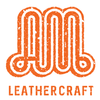
MAKERS SPOTLIGHT #7 : MIKE PIZARRO | ATELIER SCARABÉE
Mike is a courageous convert, a lover of leather and tradition, he designs unique and hand-sewn pieces, gives a second life to old leather articles, and trains in the trade of leatherworker in Paris
AM: Can you briefly introduce yourself?
MP: I am Mike Pizarro, leather craftsman, after a twelve-year experience in biomedical research to develop therapies against cancer, I decided to convert into craftsmanship to found "Atelier Scarabée".

What prompted you to make this choice?
I love working with my hands, working with leather has always been a passion for me, the nobility of the material and therefore the care and respect it requires fascinates and animates me.
What is your background/training in leather goods?
Working then in the biomedical field, I started taking evening classes over a period of two years. I then enrolled in a Parisian leather goods school to pass the CAP. I also did some internships with renowned craftsmen to consolidate my knowledge.
Tell us more about your workshop: when did you open it, where is it located?
"Atelier Scarabée" was founded in 2019, it is a factory of small and medium luxury leather goods, designed and produced entirely by hand in Paris. The workshop is part of the cultural place Villette Makerz bringing together various manufacturing workshops and co-working spaces, located in the heart of the Parc de la Villette in Paris in its emblematic red building .

How do you work? All by hand, by machine?
Each piece is individually designed and produced in accordance with the ancestral French tradition: cut, assembled, sewn, polished and pampered by the hands of a single craftsman. Each article is carefully thought out and made with love, has a soul and is intended to be passed on from generation to generation.
The manufacture of a part can count up to seventy manufacturing steps. A hand-sewn bag requires a minimum of thirty-five hours of work, not counting the drawing and making of the templates.
What type of product do you manufacture the most?
I design as many bags as small leather goods. Each piece is entirely made of leather, lining included. A tailor-made piece and a unique and unforgettable experience, each detail being of paramount importance, a prior discussion with the customer is essential.

How do you talk about yourself? What is your sales network?
I work mainly by "word of mouth", a little also with social networks, especially Instagram .
Most often, my clients contact me first for a first meeting at the workshop to discuss the details of the piece to be made, the choice of skins, etc. The cycle of design then realization can then begin. I mainly work this way but also exhibit in parallel in shops and galleries in the capital .
What is the most ambitious project you have worked on?
Each project is quite ambitious since it is unique.
I am also passionate about restoring old leather objects, antitque gun cases, boxes of cartridges among others... Sometimes a very perilous exercise, some damage is visible from the outside, once the piece is dismantled, we discover very often an additional miriad of restorations to undertake! It's a time-consuming but very satisfying exercise, I can spend weeks on a restoration, giving new life to a century-old object is always a great reward!
What are your upcoming projects in the near future?
Bequeath this rich know-how to future craftsmen.
Atelier Scarabée welcomes trainees from Parisian leather goods schools and prepares free candidates for the CAP, this requires availability, patience, passion, but also space! My workshop in the craft center of Villette Makerz is a place shared with several craftsmen and creators, we would like in the future to increase our workspace to accommodate more trainees and at least one apprentice.
Let's talk a little technical
What is the type of product that you like to design the most and/or the manufacturing step that you particularly like?
I take a lot of pleasure in practicing saddle-stitching, the gesture is harmonious, requires a certain concentration, it is for me a kind of therapy...
What type of product that you have never had the opportunity to make (for lack of time, for example) would you like to have the opportunity to make one day?
I would like to try my hand at making trunks, for this purpose, I am starting to learn cabinetmaking in a somewhat empirical way.
Do you have a favorite tool? Why this one? Does it have a particular history and/or is it simply essential and/or very practical?
My favorite tool is "L'indispensable", my cutting tip, when I use it, I sometimes have the feeling that it is one with me, it's a bit like the emblematic tool of the saddler- French leather goods makers.

Which leather goods technique/production step is the most complex for you to master? Why ?
Saddle stitching: practicing it requires good concentration, you have to calculate the angle of perforation, your strength, the tension of the thread when lacing each stitch ...
What is the advice you could give to new generations who would like to embark on the adventure as you did?
I consider that real luxury is made by hands and not by machines. Train your hands well and above all take good care of them!
Atelier Scarabée website : https://atelierscarabee.wordpress.com/
Instagram page : https://www.instagram.com/atelierscarabeeparis/

